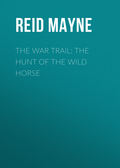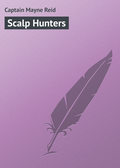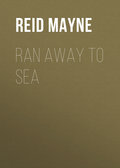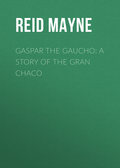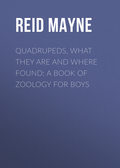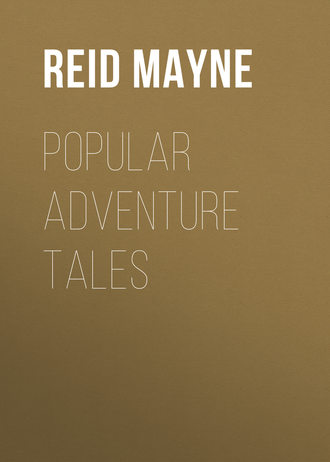
Майн Рид
Popular Adventure Tales
CHAPTER IX.
A VICUÑA HUNT
The vicuña being of such value, both inside and out, both in flesh and wool, is hunted by the mountain Indians with great assiduity. It is an animal most difficult to approach, and there is rarely any cover on these naked plains by which to approach it.
The chief mode of capturing it is by the “chacu.” This cannot be effected by a single hunter. A great number is required. Usually the whole population of one of the villages of the “Sierras” lower down turns out for this sport, or rather business, for it is an annual source of profit. Even the women go along, to cook and perform other offices, as the hunt of the chacu sometimes lasts a week or more.
A hunting party will number from fifty to one hundred persons. They climb up to the altos, or high and secluded plains, where the vicuña dwells in greatest numbers. They carry with them immense coils of ropes, and a large quantity of coloured rags, together with bundles of stakes three or four feet in length. When a proper part of the plain has been chosen, they drive in the stakes four or five yards apart and running in the circumference of a circle, sometimes nearly a mile in diameter.
A rope is then stretched from stake to stake, at the height of between two and three feet from the ground, and over this rope are hung the coloured rags provided for the occasion, and which keep fluttering in the wind. A sort of scare-crow fence is thus constructed in the form of a ring, except that on one side a space of about two hundred yards is left open to serve as an entrance for the game. The Indians then, most of them on horseback, make a grand détour, extending for miles over the country; and having got behind the herds of vicuñas, drive them within the circle, and close up the entrance by completing the ring.
The hunters then go inside, and using the bolas, or even seizing the animals by their hind-legs, soon capture the whole. Strange to say, these silly creatures make no attempt to break through the sham fence, nor even to leap over it. Not so with the guanacos, when so enclosed. The latter spring against the fence at once, and if, by chance, a party of guanacos be driven in along with the vicuñas, they not only break open the rope enclosure and free themselves, but also the whole herd of their cousins, the vicuñas. It is, therefore, not considered any gain to get a flock of guanacos into the trap.
The hunt usually lasts several days, but during that time the enclosure of ropes is flitted from place to place, until no more vicuñas can be found. Then the ropes, stakes, &c., are collected, and the produce of the hunt distributed among the hunters. But the Church levies its tax upon the “chacu,” and the skins – worth a dollar each – have to be given up to the priest of the village. A good round sum this amounts to, as frequently four or five hundred vicuñas are taken at a single chacu.
A good hunter is sometimes able to “approach” the vicuña. Guapo's friend was esteemed one of the best in all the Puna. The sight of the herd out on the plain, with their graceful forms, and beautiful reddish-orange bodies, was too much for him, and he resolved to try his skill upon them. He said he had a plan of his own, which he intended to practise on this occasion.
Don Pablo and his party – even Doña Isidora and the little Leona – were all outside the hut, although the morning air was raw and chill. But the domicile of the worthy vaquero was not empty, for all that. It was peopled by a very large colony of very small animals, and a night in their society had proved enough for the travellers. The chill air of the Puna was even more endurable than such company.
The vaquero crawled back into the hut, and in a few minutes returned, but so metamorphosed, that had the party not seen him come out of the doorway they would have mistaken him for a llama! He was completely disguised in the skin of one of these animals. His face only was partly visible, and his eyes looked out of the breast. The head and neck of the skin, stuffed with some light substance, stood up and forward, after the manner of the living animal, and although the legs were a little clumsy, yet it would have required a more intelligent creature than the vicuña to have observed this defect.
All hands, even the saturnine Guapo, laughed loudly at the counterfeit, and the vaquero himself was heard to chuckle through the long wool upon the breast. He did not lose time, however, but instantly prepared to set off. He needed no other preparation than to get hold of his bolas, – that was his favourite weapon. Before going farther, I shall tell you what sort of weapon it is.
The bolas consist of three balls – hence the name – of lead or stone, two of them heavier than the third. Each ball is fastened to the end of a stout thong made of twisted sinews of the vicuña itself, and the other ends of the three thongs are joined together. In using them the hunter holds the lightest ball in his hand, and twirls the other two in circles around his head, until they have attained the proper velocity, when he takes aim and launches them forth.
Through the air fly the thongs and balls, and all whirling round in circles, until they strike some object; and if that object be the legs of an animal, the thongs become immediately warped around them, until the animal is regularly hoppled, and in attempting to escape comes at once to the ground. Of course great practice is required before such an instrument can be used skilfully; and to the novice there is some danger of one of the balls hitting him a crack on the head, and knocking over himself instead of the game. But there was no danger of Guapo's friend the vaquero committing this blunder. He had been swinging the bolas around his head for more than forty years!
Without more ado, then, he seized the weapon, and, having gathered it with his fore-feet into a portable shape, he proceeded in the direction of the vicuñas.
The travellers remained by the hut, watching him with interest, but his movements were particularly interesting to Leon, who, like all boys, was naturally fond of such enterprises.
The herd of vicuñas was not more than three quarters of a mile off. For the first half of this distance the vaquero shambled along right speedily, but as he drew nearer to the animals he proceeded slower and with more caution.
The pretty creatures were busily browsing, and had no fear. They knew they were well guarded by their faithful sentinel, in whom they had every confidence, – the lord and leader of the herd. Even from the hut, this one could be seen standing some distance apart from the rest. He was easily recognised by his greater bulk and prouder bearing.
The false llama has passed near the guanacos, and they have taken no heed of him. This is a good omen, for the guanacos are quite as sharp and shy as their smaller cousins, and since he has succeeded in deceiving them, he will likely do the same for the vicuñas. Already he approaches them. He does not make for the herd, but directly for the leader. Surely he is near enough; from the hut he seems close up to the creature. See! the vicuña tosses his head and strikes the ground with his hoof. Listen! it is his shrill whistle. The scattered herd suddenly start and flock together; but, look! the llama stands erect on his hind-legs; the bolas whirl around his head – they are launched out. Ha! the vicuña is down!
Where is the female drove? Have they scampered off and forsaken their lord? No! faithful as a loving wife, they run up to share his danger. With shrill cries they gather around him, moving to and fro. The llama is in their midst. See! he is dealing blows with some weapon – it is a knife! his victims fall around him – one at every blow; one by one they are falling. At last, at last, they are all down, – yes, the whole herd are stretched, dead or dying, upon the plain!
The struggle is over; no sound is heard, save the hoof-stroke of the guanacos, llamas, and alpacos, that cover the plain in their wild flight.
Leon could no longer restrain his curiosity; but ran off to the scene of the slaughter. There he counted no less than nineteen vicuñas lying dead, each one stabbed in the ribs! The Indian assured him that it was not the first battue of the kind he had made. A whole herd of vicuñas is often taken in this way. When the male is wounded or killed, the females will not leave him; but, as if out of gratitude for the protection he has during life afforded them, they share his fate without making an effort to escape!
CHAPTER X.
CAPTURING A CONDOR
The vaquero with his horse soon dragged the vicuñas to the hut. Guapo gave him a help with the mule, and in a few minutes they were all brought up. One of them was immediately skinned, and part of it prepared for breakfast, and our travellers ate heartily of it, as the cold Puna air had given an edge to their appetites.
The new-killed animals, along with the red skin of the bull, which had been spread out on the ground at some distance from the hut, had already attracted the condors; and four or five of these great birds were now seen hovering in the air, evidently with the intention of alighting at the first opportunity.
An idea seemed to enter the head of the vaquero, while his guests were still at breakfast, and he asked Leon if he would like to see a condor caught. Of course Leon replied in the affirmative. What boy wouldn't like to see a condor caught?
The vaquero said he would gratify him with the sight, and without staying to finish his breakfast – indeed he had had his “coceada,” and didn't care for any, – he started to his feet, and began to make preparations for the capture.
How he was to catch one of these great birds, Leon had not the slightest idea. Perhaps with the “bolas,” thought he. That would have done well enough if he could only get near them; but the condors were sufficiently shy not to let any man within reach either with bolas or guns. It is only when they have been feasting on carrion, and have gorged themselves to repletion, that they can be thus approached, and then they may be even knocked over with sticks.
At other times the condor is a shy and wary bird. No wonder either that he is so, for, unlike most other vultures, he is hunted and killed at all times. The vultures of most countries are respected by the people, because they perform a valuable service in clearing away carrion; and in many parts these birds are protected by statute. There are laws in the Southern United States, and in several of the Spanish-American Republics, which impose fines and penalties for killing the black vultures. In some Oriental countries, too, similar laws exist. But no statute protects the condor. On the contrary, he is a proscribed bird, and there is a bounty on his head, because he does great damage to the proprietors of sheep, and llamas, and alpacos, killing and devouring the young of these animals. His large quills, moreover, are much prized in the South American cities, and the killing of a condor is worth something. All this will account for the shyness of this great bird, while other vultures are usually so tame that you may approach within a few paces of them.
As yet the half-dozen condors hovering about kept well off from the hut; and Leon could not understand how any one of them was to be caught.
The vaquero, however, had a good many “dodges,” and after the ruse he had just practised upon the vicuñas, Leon suspected he would employ some similar artifice with the condors. Leon was right. It was by a stratagem the bird was to be taken.
The vaquero laid hold of a long rope, and lifting the bull's hide upon his shoulders, asked Guapo to follow him with the two horses. When he had got out some four or five hundred yards from the hut, he simply spread himself flat upon the ground, and drew the skin over him, the fleshy side turned upward. There was a hollow in the ground about as big as his body – in fact, a trench he had himself made for a former occasion – and when lying in this on his back, his breast was about on a level with the surrounding turf.
His object in asking Guapo to accompany him with the horses was simply a ruse to deceive the condors, who from their high elevation were all the while looking down upon the plain. But the vaquero covered himself so adroitly with his red blanket, that even their keen eyes could scarcely have noticed him; and as Guapo afterwards left the ground with the led horses, the vultures supposed that nothing remained but the skin, which from its sanguinary colour to them appeared to be flesh.
The birds had now nothing to fear from the propinquity of the hut. There the party were all seated quietly eating their breakfast, and apparently taking no notice of them. In a few minutes' time, therefore, they descended lower, and lower, – and then one of the very largest dropped upon the ground within a few feet of the hide. After surveying it for a moment, he appeared to see nothing suspicious about it, and hopped a little closer. Another at this moment came to the ground – which gave courage to the first – and this at length stalked boldly on the hide, and began to tear at it with his great beak.
A movement was now perceived on the part of the vaquero – the hide “lumped” up, and at the same time the wings of the condor were seen to play and flap about as if he wanted to rise into the air, but could not. He was evidently held by the legs!
The other bird had flown off at the first alarm, and the whole band were soon soaring far upward into the blue heavens.
Leon now expected to see the vaquero uncover himself. Not so, however, as yet. That wily hunter had no such intention, and although he was now in a sitting posture, grasping the legs of the condor, yet his head and shoulders were still enveloped in the bull's hide. He knew better than to show his naked face to the giant vulture, that at a single “peck” of his powerful beak would have deprived him of an eye, or otherwise injured him severely. The vaquero was aware of all this, and therefore did not leave his hiding-place until he had firmly knotted one end of the long cord around the shank of the bird – then slipping out at one side, he ran off to some distance before stopping. The condor, apparently relieved of his disagreeable company, made a sudden effort and rose into the air, carrying the hide after him. Leon shouted out, for he thought the vulture had escaped; but the vaquero knew better, as he held the other end of the cord in his hand; and the bird, partly from the weight of the skin, and partly from a slight tug given by the hunter, soon came heavily to the ground again. The vaquero was now joined by Guapo; and, after some sharp manœuvring, they succeeded between them in passing the string through the nostrils of the condor, by which means it was quietly conducted to the hut, and staked on the ground in the rear – to be disposed of whenever its captor should think fit.
CHAPTER XI.
THE PERILS OF A PERUVIAN ROAD
It was as yet only an hour or so after daybreak – for the vicuña hunt had occupied but a very short time and the capture of the condor a still shorter. Don Pablo was anxious to be gone, as he knew he was not beyond the reach of pursuit. A pair of the vicuñas were hastily prepared, and packed upon a llama for use upon their journey. Thus furnished, the party resumed their route.
The vaquero did not accompany them. He had an office to perform of far more importance to their welfare and safety. As soon as they were gone he let loose his four snarling curs, and taking them out to where the pile of dead vicuñas lay upon the plain, he left them there with instructions to guard the carcasses from foxes, condors, or whatever else might wish to make a meal off them. Then mounting, he rode off to the place where the road leading from Cuzco ascended upon the table-land, and having tied his horse to a bush, he climbed upon a projecting rock and sat down. From this point he commanded a view of the winding road to the distance of miles below him.
No traveller – much less a party of soldiers – could approach without his seeing them, even many hours before they could get up to where he sat; and it was for that reason he had stationed himself there. Had Don Pablo been pursued, the faithful Indian would have galloped after and given him warning, long before his pursuers could have reached the plain.
He sat until sunset – contenting himself with a few leaves of coca. No pursuer appeared in sight. He then mounted his horse, and rode back to his solitary hut.
Let us follow our travellers.
They crossed the table-plain during the day, and rested that night under the shelter of some overhanging rocks on the other side. They supped upon part of the vicuñas, and felt more cheerful, as they widened the distance between themselves and danger. But in the morning they did not remain longer by their camp than was necessary to get breakfast. Half-an-hour after sunrise saw them once more on their route.
Their road led through a pass in the mountains. At first it ascended, and then began to go downward. They had crossed the last ridge of the Andes, and were now descending the eastern slopes. Another day's journey, or two at most, would bring them to the borders of that wild forest, which stretches from the foot-hills of the Andes to the shores of the Atlantic Ocean – that forest with scarcely a civilised settlement throughout all its wide extent – where no roads exist – whose only paths are rivers – whose dark jungles are in places so impenetrable that the Indian cannot enter them, and even the fierce jaguar, embarrassed by the thick underwood, has to take to the tree-tops in pursuit of his prey. Another day's journey or so would bring them to the borders of the “Montaña” – for such is the name which, by a strange misapplication of terms, has been given to this primeval wood. Yes, the Montaña was before them, and although yet distant, it could now and then be seen as the road wound among the rocks, stretching far towards the sky like a green and misty ocean.
In that almost boundless region there dwelt none but the aborigines of the soil – the wild Indians – and these only in sparse and distant bands. Even the Spaniards in their day of glory had failed to conquer it; and the Portuguese from the other side were not more successful.
The Spanish colonists, on the Peruvian or western border of this immense forest, had never been able to penetrate it as colonists or settlers. Expeditions from time to time had passed along its rivers in search of the fabled gold country of Manoa, whose king each morning gave himself a coating of gold dust, and was hence called El Dorado (the gilded); but all these expeditions ended in mortification and defeat. The settlements never extended beyond the sierras, or foot-hill of the Andes, which stretch only a few days' journey (in some places but a score of leagues) from the populous cities on the mountain-heights.
Even at this present time, if you travel thirty leagues eastward of the large town of Cuzco, in the direction taken by Don Pablo, you will pass the boundaries of civilisation, and enter a country unexplored and altogether unknown to the people of Cuzco themselves! About the “Montaña” very little is known in the settlements of the Andes. Fierce tribes of Indians, the jaguar, the vampire bat, swarms of mosquitoes, and the hot atmosphere, have kept the settler, as well as the curious traveller, out of these wooded plains.
Don Pablo had already passed the outskirts of civilisation. Any settlement he might find beyond would be the hut of some half-wild Indian. There was no fear of his encountering a white face upon the unfrequented path he had chosen, though had he gone by some other route he might have found white settlements extending farther to the eastward. As it was, the wilderness lay before him, and he would soon enter it.
And what was he to do in the wilderness? He knew not. He had never reflected on that. He only knew that behind him was a relentless foe thirsting for his life. To go back was to march to certain death. He had no thoughts of returning. That would have been madness. His property was already confiscated – his death decreed by the vengeful Viceroy, whose soldiers had orders to capture or slay, whenever they should find him. His only hope, then, was to escape beyond the borders of civilisation – to hide himself in the great Montaña. Beyond this he had formed no plan. He had scarcely thought about the future. Forward, then, for the Montaña!
The road which our travellers followed was nothing more than a narrow path or “trail” formed by cattle, or by some party of Indians occasionally passing up from the lower valleys to the mountain-heights. It lay along the edge of a torrent that leaped and foamed over its rocky bed. The torrent was no doubt on its way to join the greatest of rivers, the mighty Amazon – the head-waters of which spring from all parts of the Andes, draining the slopes of these mountains through more than twenty degrees of latitude.
Towards evening the little party were beginning to enter among the mountain spurs, or foot-hills. Here the travelling grew exceedingly difficult, the path sometimes running up a steep acclivity and then descending into deep ravines – so deep and dark that the sun's rays seemed hardly to enter them. The road was what Spanish-Americans term, “Cuesta arriba, cuesta abajo” (up hill, down hill).
In no part of the world are such roads to be met with as among the Andes Mountains, both in South America and in their Mexican continuation through the northern division of the continent. This arises from the peculiar geological structure of these mountains. Vast clefts traverse them, yawning far into the earth. In South America these are called quebradas. You may stand on the edge of one of them and look sheer down a precipice two thousand feet! You may fancy a whole mountain scooped out and carried away, and yet you may have to reach the bottom of this yawning gulf by a road which seems cut out of the face of the cliff, or rather has been formed by a freak of Nature – for in these countries the hand of man has done but little for the roads.
Sometimes the path traverses a ledge so narrow that scarce room is found for the feet of your trusty mule. Sometimes a hanging bridge has to be crossed, spanning a horrid chasm, at the bottom of which roars a foaming torrent – the bridge itself, composed of ropes and brambles, all the while swinging like a hammock under the tread of the affrighted traveller!
He who journeys through the tame scenery of European countries can form but little idea of the wild and dangerous highways of the Andes. Even the passes of the Alps or Carpathians are safe in comparison. On the Peruvian road the lives of men and animals are often sacrificed. Mules slide from the narrow ledges, or break through the frail “soga” bridges, carrying their riders along with them, whirling through empty air to be plunged into foaming waters or dashed on sharp rocks below.
These are accidents of continual occurrence; and yet, on account of the apathy of the Spano-Indian races that inhabit these countries, little is done for either roads or bridges. Every one is left to take care of himself, and get over them as he best may. It is only now and then that positive necessity prompts to a great effort, and then a road is repaired or a broken bridge patched with new ropes.
But the road that was travelled by Don Pablo had seen no repairs – there were no bridges. It was, in fact, a mere pathway where the traveller scrambled over rocks, or plunged into the stream, and forded or swam across it as he best could. Sometimes it lay along the water's edge, keeping in the bottom of the ravine; at other places no space was left by the water, and then the path ascended and ran along some ledge perhaps for miles, at the end of which it would again descend to the bed of the stream.



